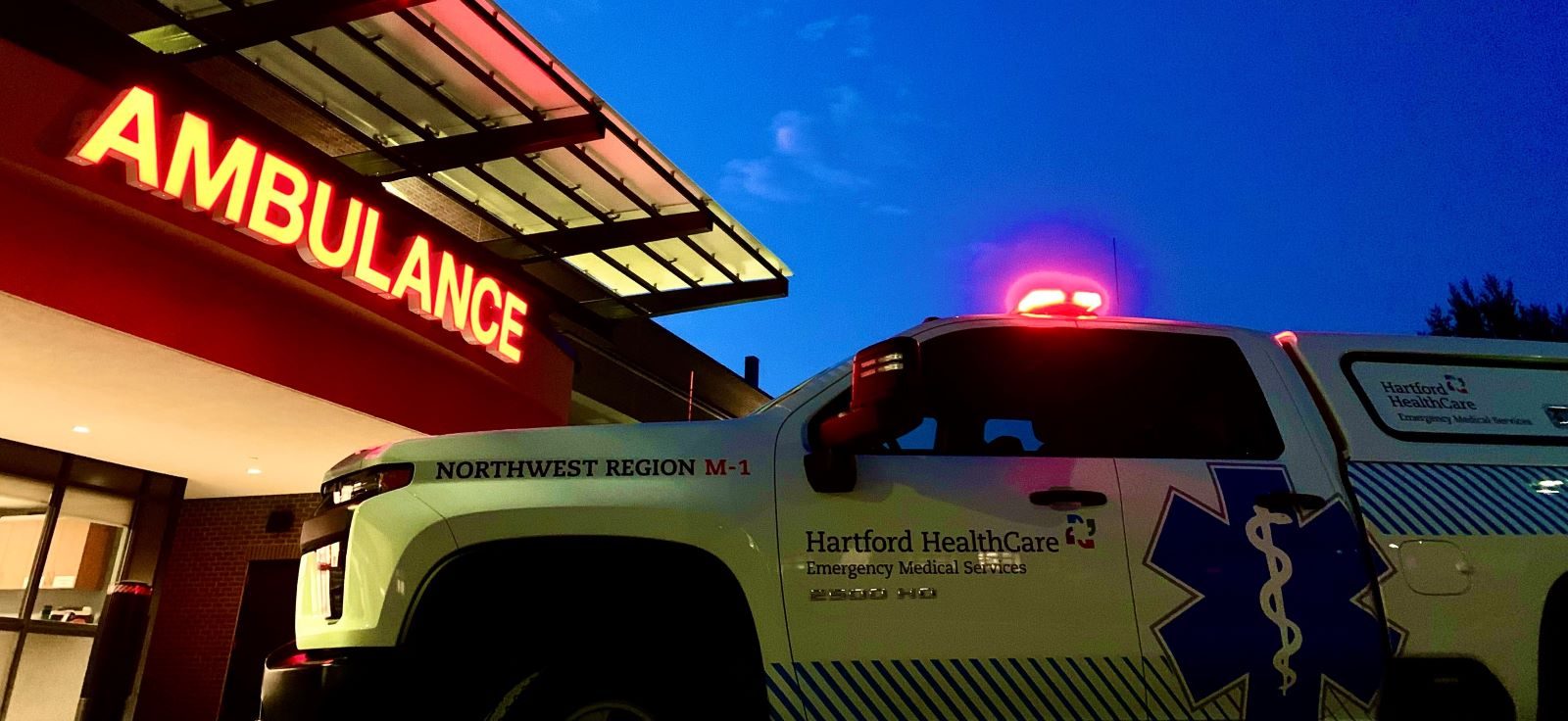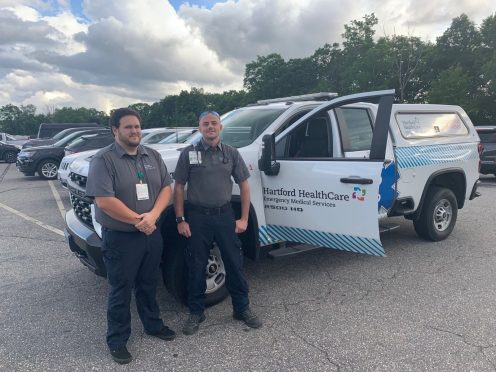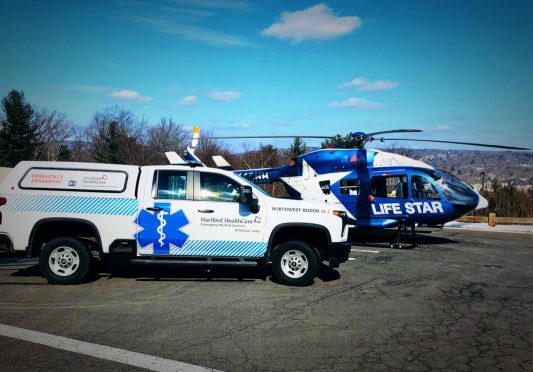<< Back
Charlotte Hungerford Paramedic Program: Delivering Life Saving Care Where and When You Need It Most

November 29, 2022

When patients in Northwest Connecticut need advanced emergency treatment before they get to the hospital, the Charlotte Hungerford Critical Care Paramedic Team can be there in a matter of minutes to provide life-saving care on the scene and begin the coordination of care on the journey to the hospital.
The emergency 911 intercept service, which celebrated its first anniversary in October, responds to calls through the Litchfield County Dispatch and serves the towns of Goshen, Harwinton, Bantam, Litchfield, Morris, Northfield, Barkhamsted, Colebrook, New Hartford, Norfolk, Winsted, Winchester and North Canaan, covering the needs of more than 40,000 residents in the Northwest area.
Paramedics maintain a critical care level of certification and can provide advanced life support to patients before they reach the hospital, including starting IVs, intubating patients and performing other more invasive procedures that might be necessary before the patient reaches an emergency department or trauma center. Working in partnership with local EMS, paramedics are with the patient on the scene and during their transport to the hospital.
The Charlotte Hungerford program has five full-time and two part-time paramedics who staff its emergency vehicle—a 2021 Chevrolet 2500 pickup truck—responding to the scene to meet local ambulance teams and EMS to begin care and prepare for transport. In cases in which a patient needs an even higher level of care, paramedics can help coordinate a LIFE STAR transport from the scene or from the local emergency department.
“Our paramedic program is so critical to our mission at Charlotte Hungerford Hospital and at Hartford HealthCare. These highly trained professionals are seeing patients at their time of greatest need and are providing timely care when and where they need it most,” said John Capobianco, senior vice president of Hartford HealthCare’s Northwest Region.
“The Charlotte Hungerford Paramedic Intercept program is a crucial part of our goal to ensure that all patients have immediate access to this high level of care. It also highlights Hartford HealthCare’s long-standing collaboration with our skilled local EMS and ambulance teams,” said Kevin Ferrarotti, senior system director for Hartford HealthCare Emergency Medical Services.
A Growing Need
The need for the service has been even greater than expected. The number of calls has increased rapidly, especially in recent months.
“We doubled expectations from when we started, we expected 50 calls a month but it has been more than 100 calls a month for the last five months,” said Fred Rosa, director of EMS for Hartford HealthCare’s Northwest Region.
The team has one vehicle based out of Charlotte Hungerford Hospital and based on the expanded need are looking at increasing access to patients when they need it the most.
They also utilize a North Canaan-based vehicle with supplies and personnel from Charlotte Hungerford to help reach that area. Making this location a second hub would give them more access to the Falls Village, Salisbury and Cornwall areas.
Like Having ICU in the Field

Ryan Antonowicz, Paramedic Program Coordinator for EMS, said the paramedics are dispatched immediately if there is a potentially life threating situation, such as chest pain or a stroke, but if a rescue crew arrives on scene and realizes it is a higher need medical call, they can call and then the Charlotte Hungerford team can be dispatched to the scene or a mutual location for treatment.
Antonowicz said the team is like LIFE STAR on the ground, and can respond in times when LIFE STAR can’t, such as during difficult weather, or serve as a backup if the helicopter is busy or grounded. All members of the team have either flight medicine or critical care certifications, these credentials are required within a year of being hired if they don’t already have them.
Using the Latest Technology to Coordinate Care
To help with coordination of care and communication with emergency departments, the team uses Twiage—an app that notifies the hospital of incoming patients.
Hartford HealthCare is the first healthcare system in the northeast to use Twiage, which is a combination of the words “Twitter” and “triage.” The pre-hospital, two-way communication system allows EMTs and paramedics to communicate directly and effectively with doctors, nurses and medical personnel prior to their arrival at the hospital with a patient who is critically ill or injured. This can help pre-register patients, and get equipment or testing services ready for arrival.
“Twiage is a game changer when it comes to patient care,” said Kevin Ferrarotti, “Ordinarily, when an EMS company en route to a hospital, they depend on radios, which can sometimes be intermittent based on service. Passing along information can also involve multiple people, too. It’s like playing a game of telephone. Twiage eliminates any communication barriers by directly supplying clinical teams at the hospital with real-time information. An EMT or paramedic can send the information in 20 seconds or less – whereas before it would sometimes take a few minutes over the radio.”
Helping Their Colleagues and Giving Back to the Community
Paramedics are based at Charlotte Hungerford Hospital and also respond to calls within the hospital emergency department when they are not on the road. They go to rapid response calls and cardiac arrests within the hospital when they are not out on calls in the region.
There are many benefits to having local paramedics as part of a rapid response team, as they are skilled at determining scene safety and immediately identifying environmental hazards. Using their enhanced assessment skills, paramedics are also able to quickly determine airway, breathing, circulatory and disability status of patients having been trained and certified in CPR, Advanced Cardiovascular Life Support (ACLS), HAZMAT, stroke, and sepsis management.
Some of the paramedics also teach at local community college paramedic programs, or lead EMT classes for fire or ambulance volunteers.
“We support the other volunteers and teams we work with through trainings and programs,” Antonowicz said. “Teaching different programs also keeps us on top of our game.”